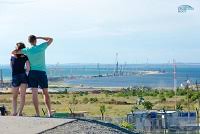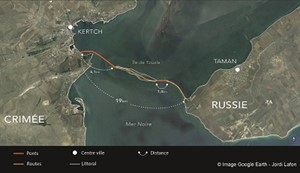 “Our grandfathers built the Siberian Baikal-Amur line. We’re going to build this bridge!” One of the promotional clips dedicated to the construction of the Kerch Bridge sets the tone from the outset by placing the building of this structure in the context of historical continuity and heritage. This is without mentioning that the construction of the railway line to which it pays tribute, completed in 1984, was started in the 1930s by Gulag prisoners. Generally presented by the Russian media as a long-awaited miracle, the Kerch Bridge, ardently supported by Russian President Vladimir Putin, is part of the policy of major works that the Soviet Union was accustomed to and which can write its promoter into the history books. To those who denounce this ambitious project as too complex, too costly, or even of questionable utility, V. Putin retorts that it is like the Sochi Olympics: too big to fail.
“Our grandfathers built the Siberian Baikal-Amur line. We’re going to build this bridge!” One of the promotional clips dedicated to the construction of the Kerch Bridge sets the tone from the outset by placing the building of this structure in the context of historical continuity and heritage. This is without mentioning that the construction of the railway line to which it pays tribute, completed in 1984, was started in the 1930s by Gulag prisoners. Generally presented by the Russian media as a long-awaited miracle, the Kerch Bridge, ardently supported by Russian President Vladimir Putin, is part of the policy of major works that the Soviet Union was accustomed to and which can write its promoter into the history books. To those who denounce this ambitious project as too complex, too costly, or even of questionable utility, V. Putin retorts that it is like the Sochi Olympics: too big to fail.
A bridge steeped in history
The President refers to the many attempts to build this bridge to affirm its historic mission. The need for this structure has been felt for a long time[1].
The idea of a bridge between these two shores dates back to 1870 when the British installed a telephone line across the Strait to link India. At the same time, it was thought that a railway bridge might follow, but this was abandoned due to a lack of funding. The idea later resurfaced in the entourage of Nicholas II, but the First World War imposed other priorities. The first works were carried out in the 1940s, when Nazi troops were established in Crimea and saw the bridge as a support for the advance of their troops into the rest of the USSR. The chief architect of the Third Reich, Albert Speer, was put in charge of the project, but as soon as construction began, Soviet troops poured in. What remained of the abandoned works was a railway line, which the Soviet delegation used on its return to Moscow after the Yalta conference! But the wooden piers could not withstand the following winter’s ice break-up, and the bridge was destroyed.
In 1952, a ferry system was set up to link the Crimean town of Kerch with Taman in southern Russia. In 2001, Moscow City Council relaunched the bridge project in partnership with the twin city of Sevastopol. The cost of the project and a territorial dispute over the island of Tuzla, in the middle of the Strait, meant that the project was never pursued. Then, in 2008, Russia and Ukraine signed an agreement, once again blocked by a lack of funding.
As soon as Russia annexed Crimea in March 2014, the project resurfaced as part of the broader issue of interconnections between the peninsula, which is linked to Ukraine and Russia. Opening up Crimea quickly became a priority for Moscow.
A masterpiece
Technically, this bridge is a real challenge. The geological conditions of the Kerch Strait do not lend themselves well to this type of construction: the seismic activity is not very favorable, the weather conditions are very changeable, and a thick layer of silt covers the bottom of the strait (which requires pilings the height of 26-story buildings)... Most bridge piers must be installed before winter, i.e., before the water is too cold or frozen and the days are too short. From November to March, windstorms are frequent. That’s why the work has been launched simultaneously at eight different points, and three weather stations are operating in the area, enabling constant adaptation. The results, found in February 2016, should allow the bridge to be opened in early 2019.
It will be the longest bridge in Europe and Russia, stretching 19km (6.1km from Kerch to the island of Tuzla, 6.5km over the island, then 1.4km from the island to the oblast of Krasnodar and 5km over a spit of land linking the oblast). By comparison, the Øresund Bridge between Copenhagen and Malmö is 7.8km long. Two bridges, parallel or superimposed depending on the section, will allow daily traffic of 40,000 vehicles (on four lanes) and 47 trains. An arch will be installed at the level of the Kerch-Enikalski channel to enable boats to travel between the Black Sea and the Sea of Azov. At this point, the bridge will reach a height of 35m above sea level[2].

The cost of the project is a “rough patch.”
Financing the project is another difficulty. It is estimated to cost more than 211 billion roubles (nearly 3 billion euros), which is not good news during a crisis. For a time, the Russian authorities hoped foreign companies would contribute to the construction and investment. At the same time, they would have provided indirect political support by acknowledging the annexation of Crimea. But we had to agree with this and rely entirely on the Russian budget. In June 2016, V. Putin’s press secretary, Dmitry Peskov, acknowledged that the bridge’s funding is a “rough patch” but nothing more[3], while the Ministry of Transport maintains no funding problem. However, various media, including Forbes, have reported delays in the advances paid by the Russian budget to the construction company Stroïgazmontaj[4].
This company, which belongs to the Russian billionaire Arkadi Rotenberg, was chosen at the beginning of 2015 without a call for tenders. Still, we know that another billionaire close to the Russian President was in the running: Gennady Timchenko was approached and, it is said, interested, but he withdrew from the race, declaring that the “project of the century” seemed excessive to him and the risks too great. A. Rotenberg, on the other hand, had no such misgivings. He regularly tells the media that he does not see this project as a way of making money but rather as a way of “contributing to the country’s growth.”
It doesn’t matter that Rotenberg - like Timchenko - is under international sanctions (his assets in the United States and European Union countries are frozen, and he cannot travel there). Moreover, Washington’s announcement on 1 September 2016 that it was stepping up these sanctions, aimed more specifically at companies close to Gazprom and the consortium building the bridge, left the Russian business community unmoved.
An additional obstacle does not seem to worry the project’s promoters anymore. Before the annexation of Crimea, the Kerch Strait was part of an area shared by Russia and Ukraine. Legally, Ukraine could call a halt to the work, as the status of the strait today is far from clear. Moscow does not seem to want to concern itself with this issue, and in March 2016, D. Peskov stated that all aspects of international law had been taken into account[5].
A bridge more political than practical?
Some people ask why we are embarking on such a massive project when other, far less costly and controversial solutions - including respect for the environment - could have solved the problem of connections.
According to transport and road construction expert Mikhail Blinkine[6], all that would have been needed was to improve and intensify the ferry line, as the traffic between the peninsula and the Krasnodar Krai is not very heavy, which does not require a bridge of this size. On the other hand, the town of Kerch (population 140,000) is home to shipyards, but activity there is low. The situation is even worse in Taman (population 10,000), an economically depressed town. The issue may be tourism, but it is, above all, political.
By claiming that Crimea is to be integrated into the Russian economy, the aim is to mark out its territory. In the Kerch region, posters have flourished since the work began, illustrated with a map of the peninsula in the colors of the Russian flag and bearing the slogan “We build bridges!” In August 2016, the Moscow Metro issued an annual series of tickets featuring the workers and engineers involved in building the bridge, with the name and photo of each person, their hometown, and a sentence summarising their role in the project and their relationship with the work. On the whole, the communications system surrounding the site is active. The bridge has its information center (most. life), Facebook account (krymsky. bridge), Instagram account (krymsky_bridge), and Vkontakte account (krymskiï most). They are packed with exciting photos and encouraging news.
On the other hand, the authorities use the bridge to demonstrate the country’s cohesion. In March 2016, on the second anniversary of the annexation of Crimea, V. Putin visited the island of Tuzla. At the same time, a famous festival was in full swing in Moscow under the slogan “We are together.” From Tuzla, the President gave a live speech broadcast on a large screen, talking about the progress of the work, the future economic development of the peninsula, and the bridge, “a symbol of our unity”[7].
Notes:
[1] Andrew Osborn, “ ‘Putin’s Bridge’ edges closer to annexed Crimea despite delays,” Reuters, 18 April 2016.
[2] Rossiïskaïa Gazeta, 17 February 2016.
[3] Novaïa Gazeta, 8 June 2016.
[4] “Bridge linking Crimea to Russia pushed back another year,” The Moscow Times, 7 July 2016.
[5] Daria Litvinova, “Why Kerch May Prove a Bridge Too Far for Russia,” The Moscow Times, 17 June 2016.
[6] The Moscow Times, 17 June 2016.
[7] Pervyi Kanal, 18th March 2016.
* Céline BAYOU is editor-in-chief of Regard sur l’Est.
Thumbnail: Source most.life.
Link to the French version of the article
Translated from French by Assen SLIM (Blog)
To quote this article: Céline BAYOU (2016), “The Kerch Bridge: Behind the technical feat, the political gesture,” Regard sur l’Est, 20 September.
